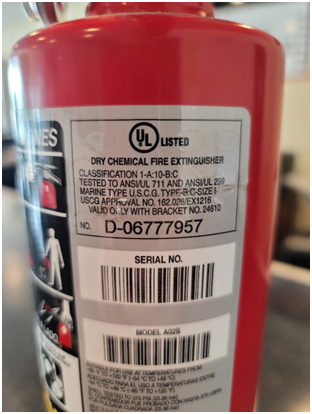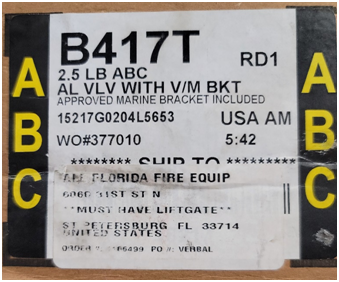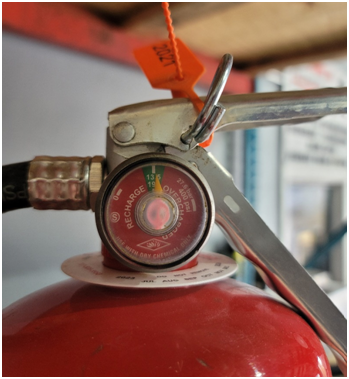Do I Need Fire Extinguishers on my Boat?
If you’re asking this question, you probably already know that the answer. If there’s a fire on your boat – do you want to be able to extinguish it? Most people would answer yes. But common sense is not common. So, what does the law require you to have?
When you are on the water in the United States, the law of the water is the United States Coast Guard. Here in the Tampa Bay area, you may also run into Florida Fish and Wildlife Conservation. Both enforce the law. So, what is the law? All boats of any size must have a marine-rated fire extinguisher, per the USCG. However, if your vessel has an engine compartment, is under 26 feet, and you have a fixed fire system, you are not required to purchase a portable fire extinguisher.
From here, the law is a bit more confusing. The USCG used a different system of rating extinguishers. They referred to extinguishers are B-1 rated or B-2 rated. Fortunately, on August 22, 2016, the USCG decided to adopt the National Fire Protection Associations guidelines for portable fire extinguishers. Making it easier to identify fire protection between the industries. So, let’s start there.
Required Fire Extinguishers
All boats with a motor need a 5-B rated extinguisher. This means the extinguisher is rated to put out a flammable or combustible liquid fire – perfect when you are using gasoline or diesel to power your engine. The requirements differ based on the size of the boat and the amount of fire protection. See the chart below:
| Boat that is: | Need: | Unless: |
| 16 feet and under | One 5-B rated extinguisher | They have a fixed fire system. |
| 16 to under 26 feet | One 5-B rated extinguisher | They have a fixed fire system. |
| Twenty-six feet to under 40 feet* | Two 5-B rated extinguishers** | |
| Forty feet to under 65 feet* | Three 5-B rated extinguishers** |
*Boats 26 feet or larger with an engine compartment are required to have a fixed fire suppression system.
**1 20-B rated fire extinguisher may be substituted for two 5-B fire extinguishers.
How to Choose a Fire Extinguisher
In older models, there will be a marine rating on the extinguisher. However, newer models may not say Size I or Size II. Because the USCG has adopted NFPA standards, marine fire extinguishers could be extinguished with a 5B or higher rating and an appropriate marine bracket. It is important to note that B-rated fire extinguishers are appropriate. Still, most people will choose an ABC-rated extinguisher as they will put out regular, explosive, and electrical fires. They are not required by law.


Both of these extinguishers are marine-rated for 10-B fires. They are considered ABC rated but have different ratings for A or “regular” material fires. To be used on a boat, they must have a USCG-approved bracket listed by the brand and part number.
Installing Fire Extinguishers
Having the correct extinguishers and the correct number of extinguishers is half the battle. Knowing where to install them to pass inspection and to find them during an emergency is the second half.
Fire extinguishers on a boat must be installed with a bracket. A bracket is different from a hook. A hook is designed for a stationary vertical installation. A bracket is used for moving surfaces and keeps the extinguisher from falling or hurting anyone. It also allows the extinguisher to be mounted horizontally. It is important to mount the extinguishers in a location that is highly visual, that is not obstructed, and that anyone can see in the case of a fire.
Many extinguishers come with a marine-approved bracket. If you cannot tell, the box will have a marking. Like the image below:

Maintaining and Certifying your Extinguisher
There are a few more considerations to make. Are you going to buy a disposable fire extinguisher or a rechargeable fire extinguisher? Which is better? How can you tell?
To be fair, neither type of extinguisher is “better.” Both types are approved by the NFPA 10 and the USCG, as long as you have the required amount of B-rated coverage for your vessel. The main difference is longevity and maintenance.
Disposable fire extinguishers are perfectly safe. They are single-use extinguishers. The law requires that these be replaced after 12 years or their first use. The benefits are they are not required to be certified by a licensed fire equipment dealer, The boat and they tend to be less expensive at the time of purchase.
Rechargeable fire extinguishers are also perfectly safe. They can be used, recharged, and recertified. This type of extinguisher must be certified annually by a licensed fire equipment dealer. Rechargeable extinguishers tend to cost more upfront, but annual certification is not expensive. It allows a technician to check the extinguisher is in proper working order. If you only use disposable extinguishers – you are required to check that they are in proper working order. Over time, people tend to save money if they use their extinguisher and have it recharged.
With either type of extinguisher, be sure to check that your extinguisher is in the proper place and the gauge is on the green before heading out on the water.
What type do I have?
How can you determine which type of extinguisher you have? Manufacturers list this information on the label, but there is an easier way. If you look at the gauge that indicates the level of charge an extinguisher has, you will easily see the difference.
If the gauge is on the green – this is a good indication. Now, look at the red portion of the gauge. (See below)


When a fire extinguisher has been discharged, the needle will move left, indicating it is depressurized. However, the words on the gauge indicate what to do. This gauge says to recharge – indicating it is a rechargeable extinguisher. If the extinguisher is disposable, it will say dispose or replace. If you are buying a fire extinguisher at a big box store, it is most likely disposable. The image on the right is for a disposable fire extinguisher. It reminds the user to replace after first use or 12 years.
If you are still hesitant about purchasing or maintaining your marine fire extinguishers, consult the professionals. The USCG offers free boat inspections that include fire safety. You can also take a picture of your fire extinguisher and a close-up of the gauge and label to discuss with a licensed fire equipment dealer. If you live in the greater Tampa Bay area, consider calling All Florida Fire. Since 1999, our company has served the fire safety needs of the Tampa Bay Area. Our customer service specialists and fire extinguisher technicians will be happy to speak with you for a free consultation. Whatever you choose, keep yourself and your vessel afloat with the proper fire protection equipment. Bon, voyage!

